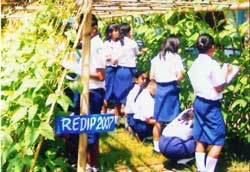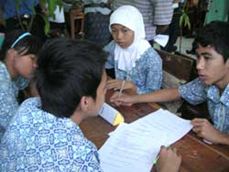
| ENGLISH |  |
BAHASA INDONESIA |  |
日本語 |
|
Regional Educational Development and Improvement Project /REDIP (Phase 2)
Period: Place: Outline: Due to those situations, it is urgent to establish an effective regional education administration system so that the government of regencies can effectively tackle with the important issues, including filling the gap of junior high school enrollment among regions and improving the education content. Japan, thus far, supported the decentralization of education administration of Indonesia by conducting research on development, development and trial introduction of a resident and school oriented education reform model (so called REDIP) in order to answer flexibly the individual demand of each community and school based on the concept of “when it comes to where to put priority in education development, those in charge (residents and school) know best.” The specific characteristics of the REDIP model are: (1) establishment of junior high school development committee and (2) proposal method education project. As the result of introducing the said model to the pilot region, the interest of parents and community toward junior high school education greatly increased, which gave a significant impact on the aspect of both access and quality. The governments of regencies subject to development research which came to recognize the effectiveness of the REDIP model, are directed toward encompassing the said model into the local education administration to continue implementing and they are proceeding with securing the regency education budget. The central government (education ministry) also thinks highly of the above mentioned project as “an education support that suits very well with the current situation of Indonesia.” However, for the education administrator of the regency to implement this model truly autonomously, it is necessary to further strengthen the administrative capabilities and the accumulation of experiences. At the same time, the places that became the subject of development research were only part of the regencies within Central Java and North Sulawesi provinces and that expanding the REDIP model regionally is the issue to work on in the future. To this end, this project is promoting: (1) the strengthening of planning and management capabilities of the regency education administrators at the site of the development research and (2) unfolding this model in other areas where junior high school enrollment is low.
|



 Return Top
Return Top